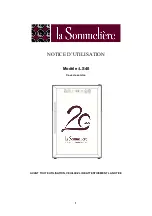
Storing your wines
The chart below indicates the ideal storage temperatures for different types of wine:-
Type of wine
Temperature
(Celsius)
Temperature
(Fahrenheit)
Red wine (*)
15.5 – 18.5°C
59.9 – 65.3°F
White wine (**)
10 - 15°C
50 – 59°F
Sparkling wines/champagne
7.2 – 9.5°C
45 – 49.1°F
Rose wine
9.5 – 10.5°C
49.1 – 50.9°F
Vintage wine
13°C
55°F
* Light red wines, such as Beaujolais, Pinot Noir and Cabernet Franc benefit from being served
slightly cooler than full-bodied reds.
** Chardonnay is often served too cold. You should chill it at a warmer temperature inside of your
wine cooler. Or leave it to warm slightly when you remove it from your wine cooler.
o
Temperature stability is the most important factor when it comes to storing wine.
o
Exposure to light, vibrations or fluctuations in temperature and humidity can all cause wine
to spoil. When properly stored, wines not only maintain their quality but many will actually
improve in aroma, flavour and complexity as they mature.
o
Wines kept at a higher temperature will age faster. Wine that is exposed to temperatures
that are greater than 22°C (72°F) will suffer from poorer flavour and aroma.
o
If wine is kept at too low a temperature, this can result in the development of harmful
deposits. A humidity of 70% is ideal for keeping corks from shrinking.
o
After a bottle of wine has been opened, the wine comes into contact with air. So it is best
to store the remainder of the bottle upright, to minimize the surface area of the wine that is
coming into contact with the air.
o
Once opened, wine will remain in a drinkable condition for two days for delicate whites or
three days for rich reds, as long as the bottle as been resealed. You should make sure that
the seal is firm by checking the stopper.
o
Special stoppers that keep wine sparking and Champagne bubbling for one or two days
after opening, can be bought at most good wine shops.
o
When stored correctly, white wines can keep well for up to two years. Full bodied reds will
age well for ten years and dessert wines will age well for up to twenty years.
o
When you buy a bottle of wine, you should transfer it to a suitable storage location
immediately (if you are not going to store it in your wine cooler).
o
Cheaper bottles of wine will not age as well as more expensive ones.
o
To make the most of the bouquet and taste of your wine, never fill more than half a glass at
a time. It will also help if the shape of your wine glass is appropriate for your wine. The size
and shape of your wine glass’s bowl will determine the intensity and complexity of the
bouquet. The stem should be long enough to allow you to avoid hand contact with the bowl
of the glass and should be tulip-shaped or tapered at the top.









































